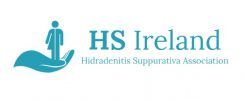Interesting Open Access Hidradenitis Suppurativa (HS) Reads – September 2024
Some interesting #openaccess #HidradenitisSuppurativa (HS) reads that appeared in PubMed during September 2024
1. Association Between Hidradenitis Suppurativa and Hyperthyroidism
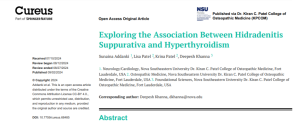
The authors of this study investigated the relationship between HS and hyperthyroidism. They performed a cross-sectional study to assess the prevalence of HS in individuals with and without a history of hyperthyroidism matched by age ranges and health surveys. The authors found a statistically significant correlation between hyperthyroidism and increased prevalence of HS. They appeal for further research into the role of hyperthyroidism in HS and potential screening tools and lifestyle management techniques that may be prevalent for both conditions.
Article link
Citation: Addanki S, Patel L, Patel K, Khanna D. Exploring the Association Between Hidradenitis Suppurativa and Hyperthyroidism. Cureus. 2024 Sep 2;16(9):e68485. doi: 10.7759/cureus.68485. PMID: 39364517; PMCID: PMC11448962.
2. HS and Female Infertility
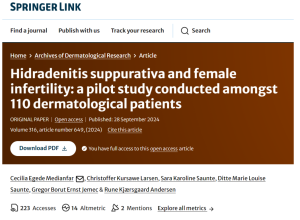
A concern for some females with HS is a possible increased risk of infertility associated with HS. To address this, the researchers performed a cross-sectional analysis of 161 females comprising 55 patients with HS, 55 patients with other dermatological diseases, and 51 controls. The authors report no significant difference between the three groups regarding whether they had children, the number of children they had, infertility, or whether they had received fertility treatments. Logistical analyses found no correlation between HS and infertility, and adjusting for factors affecting infertility did not alter this result. This study did not find a significant difference in infertility between patients with HS compared to those with other dermatological diseases, and 51 controls.
Article link
Citation: Medianfar CE, Kursawe Larsen C, Saunte SK, Saunte DML, Jemec GBE, Andersen RK. Hidradenitis suppurativa and female infertility: a pilot study conducted amongst 110 dermatological patients. Arch Dermatol Res. 2024 Sep 28;316(9):649. doi: 10.1007/s00403-024-03390-6. PMID: 39340542.
3. HS in Special Populations: Children, Pregnant and Breastfeeding Women, and the Elderly
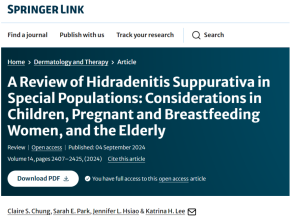
Hs is difficult to manage and treat. Certain groups merit additional attention, and the authors of this review examine HS in four special populations: children, the elderly, pregnant individuals, and breastfeeding mothers. This review highlights the overall lack of primary literature addressing HS management in these populations and emphasises the need for further research to optimise HS care across all stages of life.
Article link
Citation: Chung CS, Park SE, Hsiao JL, Lee KH. A Review of Hidradenitis Suppurativa in Special Populations: Considerations in Children, Pregnant and Breastfeeding Women, and the Elderly. Dermatol Ther (Heidelb). 2024 Sep;14(9):2407-2425. doi: 10.1007/s13555-024-01249-2. Epub 2024 Sep 4. PMID: 39230800.
4. Underestimated Burden of HS in the US
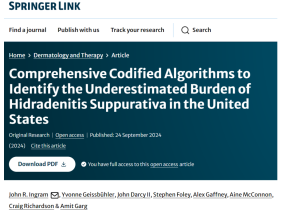
Reported estimates of HS prevalence in the literature can vary widely due to differing estimation methodologies. This retrospective cohort study applied stepwise algorithms to explore four databases to try to estimate the prevalence of possible/diagnosed cases of HS in the US. Possible/diagnosed cases of HS were identified using algorithms that assessed symptoms such as multiple skin boils in site-specific areas based on ICD codes. Patients with diagnosed HS were defined as having ≥ 2 outpatient or ≥ 1 inpatient diagnosis codes of HS. The authors report that the algorithms used found higher prevalences of HS when compared with ICD codes, highlighting that HS diagnosis codes alone may be insufficient to estimate the prevalence of HS. Applying robust methods to identify the prevalence of HS may improve the diagnostic delay observed in HS and improve treatment outcomes.
Article link
Citation: Ingram JR, Geissbühler Y, Darcy J 2nd, Foley S, Gaffney A, McConnon A, Richardson C, Garg A. Comprehensive Codified Algorithms to Identify the Underestimated Burden of Hidradenitis Suppurativa in the United States. Dermatol Ther (Heidelb). 2024 Sep 24. doi: 10.1007/s13555-024-01259-0. Epub ahead of print. PMID: 39316357.
5. Systematic Review on the Association Between HS and Obesity, Smoking, and Diabetes Mellitus
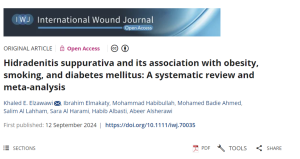
This meta-analysis aimed to quantify the association between HS and risk factors including obesity, smoking, and type 2 diabetes mellitus (T2DM). The authors searched PubMed, Scopus, Embase, Web of Science, and cumulative index to nursing and allied health literature for articles reporting either the odds ratio or the numbers of HS cases associated with obesity, smoking, or T2DM, and including HS negative controls. The analysis showed a significant association between HS and T2DM, obesity, and smoking. The authors call for an holistic management approach to mitigate against these risks.
Article link
Citation: Elzawawi KE, Elmakaty I, Habibullah M, Ahmed MB, Al Lahham S, Al Harami S, Albasti H, Alsherawi A. Hidradenitis suppurativa and its association with obesity, smoking, and diabetes mellitus: A systematic review and meta-analysis. Int Wound J. 2024 Sep;21(9):e70035. doi: 10.1111/iwj.70035. PMID: 39267324.
6. HS as an Autoinflammatory Skin Disease

The authors of this review examine the current scientific background supporting the contribution of autoinflammation to HS aetiology, including genetic data, molecular studies and clinical evidence, as well as the association between HS and AIDs. The authors emphasise the need for further research to elucidate the pathogenic mechanism(s) of HS and to identify potential perspectives for future therapeutic approaches.
Article link
Citation: D’Onghia M, Malvaso D, Galluccio G, Antonelli F, Coscarella G, Rubegni P, Peris K, Calabrese L. Evidence on Hidradenitis Suppurativa as an Autoinflammatory Skin Disease. J Clin Med. 2024 Sep 2;13(17):5211. doi: 10.3390/jcm13175211. PMID: 39274425.
7. Factors Affecting Wound Healing After Wide Excision Surgery for HS
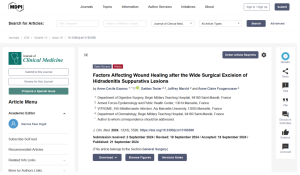
All HS care, management, and treatment guidelines acknowledge the important role surgery plays in treatment options. This study explored factors influencing healing in HS after wide excision surgery. The review analysed data from 160 patients who underwent wide excision in the axillae, inguinal-ano-genital, and other locations (including gluteal) at a single centre and focused on factors influencing the time to wound closure (TTWC). Factors negatively influencing TTWC included axillary localization and the presence of another inflammatory disease. Factors positively influencing healing were smoking and previous or ongoing medical treatment (antibiotherapy or biologics). Obesity or being overweight did not impact the TTWC in multivariate analysis, although overweight was significant in univariate analysis. The authors stress that patients with an inflammatory disease or those undergoing surgery for an axillary lesion exhibit slower healing and should be informed of potential healing delays before surgery.
Article link
Citation: Ezanno AC, Texier G, Marchi J, Fougerousse AC. Factors Affecting Wound Healing after the Wide Surgical Excision of Hidradenitis Suppurativa Lesions. J Clin Med. 2024 Sep 21;13(18):5598. doi: 10.3390/jcm13185598. PMID: 39337085.
8. Dermatopathological Insights and Surgical Success Strategies in HS
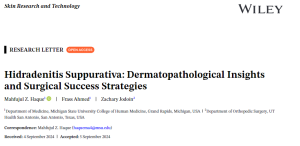
There is a dearth of literature regarding outcomes for patients with HS undergoing surgery. This article outlines crucial considerations for surgeons when treating patients with HS and provides evidence-based recommendations for treating patients with HS. The authors provide a comprehensive set of recommendations regarding the pre-, peri-, and post-operative care for patients.
Article link
Citation: Haque MZ, Ahmed F, Jodoin Z. Hidradenitis Suppurativa: Dermatopathological Insights and Surgical Success Strategies. Skin Res Technol. 2024 Sep;30(9):e70069. doi: 10.1111/srt.70069. PMID: 39300807.
9. Squamous Cell Carcinoma and HS: Case Report and Literature Review
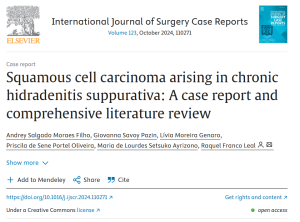
Increasing evidence highlights a link between squamous cell carcinoma (SCC) and HS, especially in men with HS. In this case report, the authors present the case of a 58-year-old male with HS who developed SCC. The patient underwent chemotherapy and radiotherapy, but the lesions recurred, necessitating abdominoperineal amputation of the rectum.
The authors also review the literature regarding SCC and HS and highlight that SCC with HS, although rare, is severe with high early metastasis and mortality.
Article link
Citation: Filho ASM, Pazin GS, Genaro LM, Oliveira PSP, Ayrizono MLS, Leal RF. Squamous cell carcinoma arising in chronic hidradenitis suppurativa: A case report and comprehensive literature review. Int J Surg Case Rep. 2024 Oct;123:110271. doi: 10.1016/j.ijscr.2024.110271. Epub 2024 Sep 10. PMID: 39260341.
10. HS and Cancer
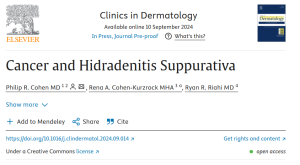
This review focuses on cancer and HS. Patients with HS have an increased risk of developing cancer, especially cutaneous SCC originating within the HS lesions. In addition to SCC, there are links between HS and hematologic malignancies and solid tumours. Furthermore, both primary visceral cancer and skin metastases from solid tumours can masquerade as HS. Following on from this, the authors recommend evaluation of a new lesion–especially if characterized by rapid growth and ulceration–located at the site of prior or current HS lesions.
Article link
Cohen PR, Cohen-Kurzrock RA, Riahi RR. Cancer and Hidradenitis Suppurativa. Clin Dermatol. 2024 Sep 9:S0738-081X(24)00183-4. doi: 10.1016/j.clindermatol.2024.09.014. Epub ahead of print. PMID: 39260459
